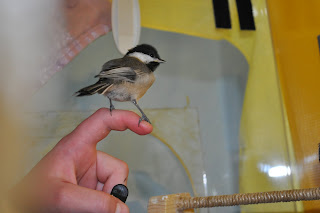 |
| photo by LMB |
The second question is what was the bird doing before you discovered it and what has it been doing since? Also note whether or not any injuries are obvious.
It may seem like baby birds are a product of spring, but here in Wisconsin we have several species of songbirds that nest later in the season and also some that nest several times throughout the season. Just because it’s July doesn’t mean baby bird season has stopped here at the Wildlife In Need Center!
So, what do you do now that you’ve found a baby bird?
Baby birds that still have lots of pink skin showing and whose feathers are soft and fuzzy or nonexistent are called nestlings. Nestlings are babies that should be in the nest but may fall out due to weather, predators, or other forces. Baby birds that don’t have any obvious injuries should first be warmed up to body temperature under a lamp, on a heating pad, or in your hand before being renested. Those that can be replaced in their original nest should be. In cases where the nest has been destroyed or is too high to reach the baby can be replaced in a substitute nest. A substitute nest can be made of a wicker basket, hanging plant basket or any plastic container with drainage holes poked into it. If using a plastic container be sure to line it with dried grasses, sticks or leaves so that it isn’t slippery. Hang your substitute nest at least 4-6 feet off the ground so it is out of easy reach of neighborhood pets and kids and within hearing distance (less than 12 feet) of the original nest. Don’t feed the baby; it should be hungry and peep because of it – that noise alerts the parents to where it is and they will feed it as well as any siblings in the nest.
Fledglings are babies that are old enough to leave the nest. They spend a couple of days hopping around the ground and making buzz flights an inch or two above the ground a foot or two at a time. That is how they learn to fly and build up their strength; activities they can’t do in a nest. Their parents continue to feed them on the ground but don’t stay with the baby at all times. Fledglings are mostly feathered, with wing feathers and at least a start of tail feathers, but may still have a bit of baby fluff here and there. Babies at this stage should be left alone and monitored from a distance.
If you have any further questions or you feel that the baby bird you’ve found may be injured please contact your nearest wildlife rehabilitator as soon as possible.


No comments:
Post a Comment